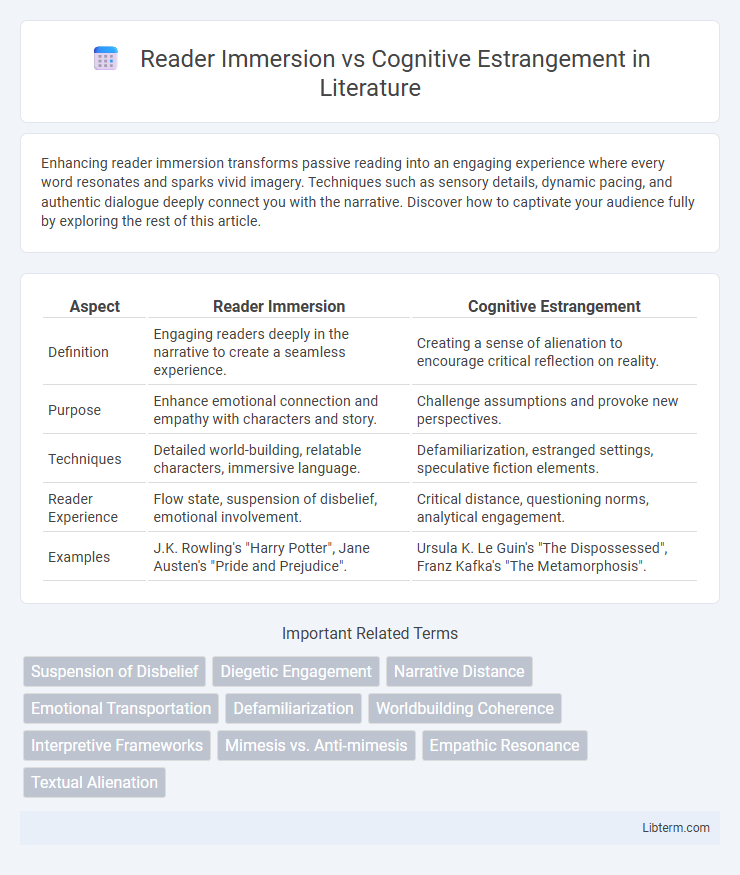Enhancing reader immersion transforms passive reading into an engaging experience where every word resonates and sparks vivid imagery. Techniques such as sensory details, dynamic pacing, and authentic dialogue deeply connect you with the narrative. Discover how to captivate your audience fully by exploring the rest of this article.
Table of Comparison
| Aspect | Reader Immersion | Cognitive Estrangement |
|---|---|---|
| Definition | Engaging readers deeply in the narrative to create a seamless experience. | Creating a sense of alienation to encourage critical reflection on reality. |
| Purpose | Enhance emotional connection and empathy with characters and story. | Challenge assumptions and provoke new perspectives. |
| Techniques | Detailed world-building, relatable characters, immersive language. | Defamiliarization, estranged settings, speculative fiction elements. |
| Reader Experience | Flow state, suspension of disbelief, emotional involvement. | Critical distance, questioning norms, analytical engagement. |
| Examples | J.K. Rowling's "Harry Potter", Jane Austen's "Pride and Prejudice". | Ursula K. Le Guin's "The Dispossessed", Franz Kafka's "The Metamorphosis". |
Defining Reader Immersion: An Overview
Reader immersion refers to the deep mental engagement where readers lose awareness of the real world and become absorbed in the narrative, often triggered by vivid descriptions and relatable characters. It involves sensory and emotional involvement that creates a seamless experience, allowing the reader to mentally visualize and emotionally connect with the story. This cognitive absorption contrasts with cognitive estrangement, which deliberately disrupts familiarity to provoke critical reflection and challenge readers' perceptions.
What is Cognitive Estrangement?
Cognitive estrangement is a literary technique that defamiliarizes the familiar by presenting familiar concepts in an unfamiliar or altered context, prompting readers to critically examine their own realities. This concept, central to science fiction and speculative fiction, challenges readers' perceptions by creating a sense of alienation that encourages reflection rather than passive immersion. By disrupting everyday assumptions, cognitive estrangement fosters a deeper intellectual engagement and questioning of societal norms.
Contrasting Immersion and Estrangement
Reader immersion involves deep engagement where the narrative creates a seamless, believable reality, allowing readers to lose themselves in the story's details and emotions. Cognitive estrangement, central to speculative fiction theory, deliberately introduces unfamiliar or defamiliarizing elements that disrupt normal perceptions, prompting critical reflection on societal norms or realities. Contrasting immersion's empathetic absorption, estrangement cultivates analytical distance, encouraging readers to question rather than fully identify with the narrative world.
Psychological Mechanisms in Reader Experience
Reader immersion engages psychological mechanisms such as flow state and emotional resonance, allowing readers to experience narrative worlds vividly and empathetically. Cognitive estrangement activates critical thinking and metacognitive awareness by defamiliarizing the familiar, prompting readers to question assumptions and actively interpret meanings. These contrasting mechanisms balance immersive absorption with reflective distance, shaping diverse cognitive and emotional reader experiences.
Immersive Techniques in Narrative Fiction
Immersive techniques in narrative fiction employ detailed world-building, sensory descriptions, and character-focused perspectives to deeply engage readers, creating a seamless experience that blurs the line between story and reality. These methods emphasize emotional resonance and identification, allowing readers to inhabit the fictional world fully, contrasting with cognitive estrangement's intent to provoke critical reflection by highlighting the artificiality of the narrative. Skillful use of immersive storytelling enhances readers' suspension of disbelief and fosters a profound connection to the narrative's environment and characters.
Tools of Cognitive Estrangement in Literature
Tools of cognitive estrangement in literature include defamiliarization, speculative world-building, and unconventional narrative structures that disrupt readers' expectations, prompting critical reflection on reality. Techniques such as allegory, metaphor, and dystopian settings create distance between the reader and the text, encouraging an analytical rather than immersive experience. These methods challenge accepted norms and highlight social or political critiques by presenting altered realities that contrast with familiar experiences.
Effects on Reader Engagement and Understanding
Reader immersion enhances engagement by creating a seamless narrative world, allowing readers to emotionally connect and mentally visualize the story, which improves comprehension and retention. Cognitive estrangement prompts critical thinking by introducing unfamiliar or speculative elements that challenge readers' assumptions, fostering a deeper intellectual engagement with themes and concepts. Both techniques influence understanding differently: immersion promotes empathetic absorption, while estrangement encourages analytical reflection.
Genre Examples: Immersion vs Estrangement
Reader immersion thrives in genres like fantasy and romance by creating detailed, believable worlds that draw readers deeply into the narrative, fostering empathy and emotional involvement. Cognitive estrangement dominates in science fiction and dystopian literature, presenting unfamiliar, speculative realities that challenge readers' perceptions and encourage critical reflection on societal norms. Both techniques leverage genre conventions to manipulate reader experience, either by enhancing identification or provoking thoughtful distance.
Critical Perspectives on Reader Response
Reader immersion encourages deep emotional engagement and identification with the narrative, fostering a seamless experience where readers become absorbed in the fictional world. Cognitive estrangement, prominent in science fiction and speculative genres, prompts readers to critically reflect on the text by highlighting unfamiliar or defamiliarized elements that challenge their assumptions. Critical perspectives on reader response emphasize how these modes influence interpretive strategies, with immersion promoting empathetic understanding and estrangement facilitating critical distance and ideological critique.
Balancing Immersion and Estrangement in Modern Storytelling
Balancing reader immersion and cognitive estrangement in modern storytelling enhances engagement by deeply involving readers in the narrative while prompting critical reflection on familiar realities. Effective narratives employ immersive techniques like rich sensory details and relatable characters alongside estrangement strategies such as altered realities, speculative elements, or defamiliarization to disrupt conventional perspectives. This dynamic interplay encourages readers to emotionally connect with the story while intellectually questioning societal norms, fostering both empathy and critical thinking.
Reader Immersion Infographic

 libterm.com
libterm.com